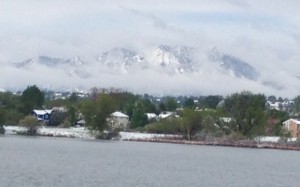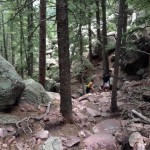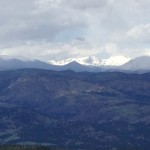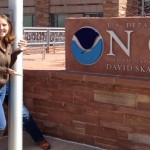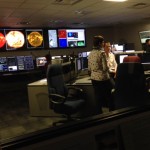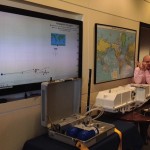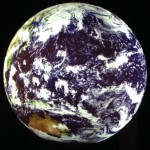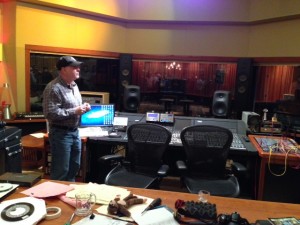Flying home from Fargo, arrived in Denver to near white-out conditions. SNOW.
Woke Sunday – everything blanketed white, temps in the upper 30’s & SUNSHINE. Happy Mother’s Day 2015 🙂
Spring snow – especially precip received in mid-May – never hangs around long. Enjoyed a long walk with the dogs around Waneka, best way to start a day. Sno’ Ro couldn’t have been happier, burying his face multiple times, coming up bearded white. Amazing skyline – night’s storm cleared all sky clutter – local Flatirons spired majestically through the low hanging clouds. SPECTACULAR!
Royal Arch, Boulder (6,915ft) – Sunday May 10th
Generally I laze around after marathoning but with fresh snow wanted to get out & get my hike on. The Rockies have gotten socked with heavy Spring snow for the past two weeks (high avalanche danger), so settled on a local day hike in Boulder – one of my faves, Royal Arch. Gloves, boots, snow pants & a tee – typical Spring hiking attire in Colorado.
[Things can change fast in the mountains – although I hike light, always pack a jacket.]
NCAR to Chautauqua, Chautauqua UP to Royal Arch. Good to get some altitude. Hiked Royal Arch in 2012 & 2013. Missed last year – trail closed due to Flood Damage. No better way to celebrate 7 weekends marathoning.
“In God’s wildness lies the hope of the world – the great fresh unblighted, unredeemed wilderness. The galling harness of civilization drops off, and wounds heal ere we are aware.” – John Muir
Bear Peak, Boulder (8,461ft) – Sunday May 17th
Week ago I arrived in North Dakota, mentally dragging – travel fatigued, burnt-out. 4-mile hike to Royal Arch, got some altitude & started the process of healing. Bouncing back, finding balance. In the gym Wednesday, Thursday, Friday.
Whenever not marathoning, I’ll be in the mountains – hiking, climbing, trail running, backpacking. Mind’s more alert, no ‘zone out’ option or risk injury falling over rocks/exposed roots. My quads ache, steadily climbing/pushing UP. The unevenness of bouldering & trail running is the antithesis of repetitious road running. Good for the soul.
Finished front porch Spring planting yesterday – first step in re-imagining my home after Ash & Tom’s move next month. Change.
“Thousands of tired, nerve-shaken, over-civilized people are beginning to find out that going to the mountains is going home; that wildness is a necessity; and that mountain parks and reservations are useful not only as fountains of timber and irrigating rivers, but as fountains of life.” – John Muir
Drove to Boulder to hike Devils Thumb with my friend Cliff. Departed Shanahan Trailhead in South Boulder, hiked Mesa Trail to Shadow Canyon, then UP UP UP more than 2,000ft vertical. Popped up on the saddle between South Boulder & Bear Peaks. 15 minutes north thru charred forest (Flagstaff fire 2013), short boulder incline & a rock scramble, summitted Bear Peak – first time since Thanksgiving 2012.
Downed half a turkey-cheese sub & took in the scenery, Longs Peak shrouded heavy white. Crazy beautiful. Caught some rain AND some sunshine on the hike return – just short of 10 miles total, 2,900ft+ vertical 🙂
Hot shower & Chinese take-out (broccoli/garlic sauce). Good day. LOVE LOVE my Colorado life!
- Shanahan trail
- Shadow Canyon – over 2,000ft vertical
- SUMMIT SUCCESS!
- Longs Peak shrouded heavy white
- when not marathoning, summit selfies
Fast becoming my favourite of all holidays as we celebrate the vast, diverse planet we live on.
Two years ago my employer provided seeds & small clay pots – and we planted on Earth Day. This year PS sponsored a company outing to NOAA – the National Oceanic & Atmospheric Administration, located here in Boulder.
Aside from the crazy amount of security required to enter NOAA, whatta super interesting day.
NOAA monitors climate change – measuring greenhouse gases in the atmosphere & the acidification of our oceans.
Discussing ice core samples extracted from Greenland & Antarctica, I got lost in the science & unfortunately zoned out when we walked down the National Weather Service hallway. Plugged back in as our guide discussed CO2 collection & plotting atmospheric data.
Ended our day by the Earth Ball, a model plotting everything from global electricity usage & oceanic warm spots to Facebook user locales.
Inspired to become more Earth-friendly, have personally committed to reusable bags this year. Be good to Mother Earth folks, we share space on this beautiful, live-giving planet. If not for you, do it for future generations 🙂
- NOAA – Nat’l Oceanic & Atmospheric Administration
- monitoring weather on our Sun & neighboring planets
- collecting samples & plotting atmospheric CO2 data
- Mother Earth – the remarkable planet we share
Antarctica May Have Hit Highest Temperature on Record
By Brian Clark Howard, National Geographic
PUBLISHED MARCH 31, 2015
Scientists have measured what is likely the highest temperature ever on Antarctica: 63.5 degrees Fahrenheit.
The measurements were made last Tuesday at Argentina’s Esperanza Base, on the northern tip of the Antarctic Peninsula, according to the meteorological website Weather Underground. The previous hottest known temperature on the continent was 62.8°F (17.1°C), recorded at Esperanza Base on April 24, 1961.
The Weather Underground called last week’s temperatures a “remarkable heat wave,” although they occurred during the end of the austral summer, when Antarctic temperatures are typically highest.
The temperature has yet to be certified as an official record for the continent by the World Meteorological Organization.
It’s hard to draw much conclusion from a single temperature record, cautions Gavin Schmidt, a climate scientist with NASA’s Goddard Institute for Space Studies in New York City. Last year Antarctica also logged a record cold temperature, he notes.
What’s more important are the long-term trends, says Schmidt. And when it comes to Antarctica, he points out, the past few years “have actually been quite complex.”
The world’s ocean has been warming rapidly, absorbing much of the planet’s excess heat. As a result, large glaciers on or around Antarctica that come in contact with the warming water have been melting rapidly. But some other glaciers farther inland on the continent are actually growing.
“That has not been satisfactorily explained,” says Schmidt.
The science is particularly complex because the ozone hole continues to affect the region’s climate in ways that aren’t well understood. And global circulation of winds and currents remains a challenge for scientists to grasp.
“One record warm temperature doesn’t cut through all that complexity,” says Schmidt.
When it comes to the whole planet, the Earth remains on track to warm by an average of at least two degrees C (3.6 degrees F) by the end of the century, scientists report, although precisely how much is expected to depend on countries’ abilities to reduce emissions of heat-trapping greenhouse gases.
Often I feel disadvantaged to other PSers (PS Audio employees) because of my lack of industry knowledge. Luckily in my current finance role, numbers are numbers – but this deficiency requires me to focus listen in weekly Manager meetings…DACs (digital-to-analog converters), DSD (direct-stream digital), transports, transformers, toslinks – been quite the learning curve.
Visited a local recording studio today. One of my favourite work excursions to date – lotta music, lotta industry talk (yep, completely over my head)…but overall, super interesting – even to us audio novices.
CLICK to listen to Boulder’s Elephant Revival or visit https://elephantrevival.com/
Food for thought by Paul McGowan
My wife Terri organizes company field trips. We do two a year and they’re always welcome, fun events. This year the entire company invaded the Super Audio Center run by Gus Skinas as well as toured Immersive Studios (the only recording studio in the world with a full 32 track Sonoma DSD recording system).
Gus treated us to many sonic delights. It was a real ‘ear-opener’ to many in the company who had never heard recorded music sound so live.
One piece of information that stood out for me, relative to yesterday’s discussion about Soft Edges, was a comment Gus made about PCM vs. DSD and analog. It isn’t often we hear about the differences between the two formats from the recording engineer’s viewpoint and I found it illuminating. His comment concerned multitrack recording and mixing as most studios do today.
Multitrack recording incorporates a separate ‘track’ or, in today’s lexicon, ‘file’ for each microphone used. So, imagine we have a small group of performers: two singers, a drum kit, stand up acoustic bass and a keyboard, each separately mic’d. Each of the five microphone feeds are sent through individual A/D converters and stored on a computer’s hard drive. When it’s time to playback and mix the five channels to a stereo version, the tracks are digitally mastered according to the recording engineer’s mix and then converted to analog through a stereo D/A converter into analog. It is in the digital mixing process where the differences between PCM and DSD really become apparent.
When the recording engineer mixes the five mono channels into stereo he does so digitally and places each channel into either left, right, center, or a combination of L and R to replicate the placement of the performers in acoustic space. When the session is an analog or DSD capture, the process is straightforward and everything works according to Hoyle: each instrument occupies the correct space and the listener can easily discern their position in space: left, right, front back. But when the session is a PCM capture, the acoustic space gets muddled and more difficult to separate between instruments, requiring the recording engineer to change EQ settings and manipulate the sound of the track to get it right.
What’s fascinating about this observation is that analog, with its limited dynamics and frequency response (relative to DSD or high sample rate PCM) does not experience this issue, nor does DSD (which is closer to analog).
Interesting stuff for thought.

